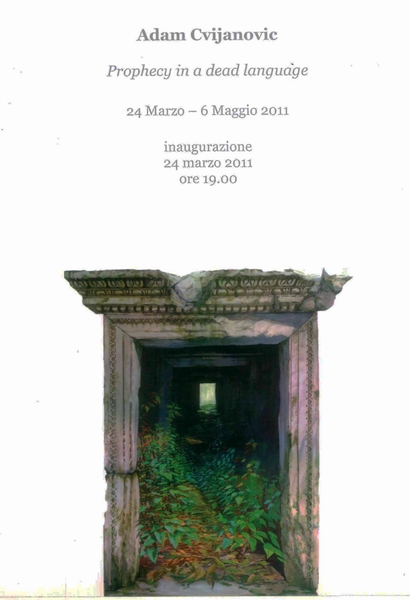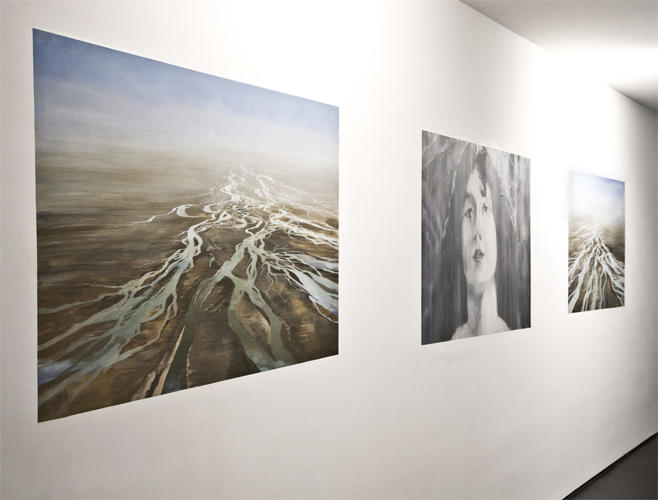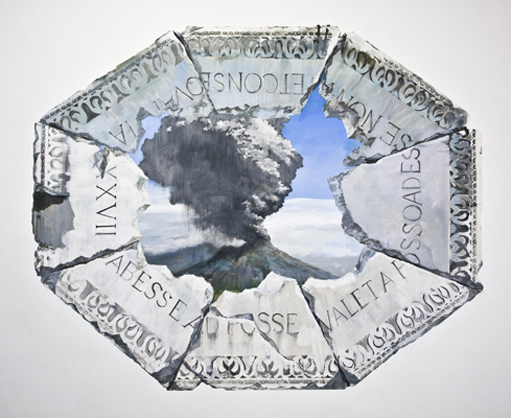
Prophecy in a dead language
Edited by Memmo Grilli
24 march - 6 may 2011
At: BLINDARTE NAPOLI
ADAM CVIJANOVIC
Blindarte contemporanea is proud to announce the second personal exhibition at its gallery by the New Yorker artist Adam Cvijanovic. The exhibition "Prophecy in a dead language" will open on 24 March 2011, at 7,00 pm, and will close on 6 May. Among the most interesting figurative painters of the contemporary art scene in New York, Adam Cvijanovic presents new works purposely created for the Neapolitan gallery with his famous technique of portable murals, inspired by Renaissance frescoes. Portable murals are paintings made on tyvek paper and put directly on the wall so to create installations involving the whole exhibition space and which can be easily removed and applied elsewhere. The exhibition draws inspiration from the famous Cumaean Sybil, probably the most important among the Sybils, priestess of Apollo and prophetic figure of ancient Rome, whose seat was reported to be a cave not far from the ancient town of Cumae, the cave mentioned by Virgil in his Aeneid. His books were very important in the archaic Roman religion, in fact they were consulted only in emergencies and to solve enigmas relating to the most important decisions to be made. They were imported to Rome at the times of Tarquinius Priscus and kept at the Capitoline temple of Jupiter first, and then on the Palatine hill. They were burnt by the Roman General Stilicho in AD 405. As a matter of fact, the exhibition does not make any specific reference to the Sybil or to the famous image of the Cumaean cave, but it generically refers to the idea of prophecy, which reminds - in our culture - the image of the Cumaean Priestess. Strongly fascinated by the remains and ruins symbolizing the decline of the American contemporary culture, Adam Cvijanovic - by following the conviction about the cyclic recurrence of events in history - goes farther in time by reproducing, probably in a critical manner, the ruins dating back to Ancient Rome in the state of neglect as they are nowadays. In the first exhibition space of the gallery, four portable murals are applied in the middle of the four walls reproducing four different ruins of entrances, all dating back to Roman times, but relating to different periods, inspired by the ruins of Leptis Magna (close to Al Khums in Lybia). The four passages, put on the wall as the four cardinal points of the compass, represent possible escapes, beyond which different landscapes are visible leading towards unknown and uncertain destinations. The recreated place is therefore prophetic, somehow magical, timeless as the ruins which characterize it and raise the dilemma of choosing. Hung on the ceiling, in the middle of the room, so to partially hide the sight of the four passages, there is an installation shaped as a double pyramid with six hexagonal faces, covered with paintings portraying the sea. As in the Roman legends, here is the sailor with his boat facing the fortune-teller and his destiny. Before his eyes, the ruins and the prophecy allow to give a misty glance to a different perception of time. The same technique used for the works on the walls creates a strong architectural relationship with the environment. And if the ruins are characterized by their permanency over time, the portability of the frescoes draws the attention on the issues of time and temporariness of contemporary events. The second exhibition space houses another large wall work: the wheel of fortune. The artist portrays the ruins of a large Roman plaque shaped as a wheel, which was misrestored several times, and which currently looks like a puzzle of different broken marble pieces where the writings - reproducing common Latin aphorisms - are discontinued by breaks so that they are not readable. In the same room, other paintings on tyvek on walls reproduce divining animals. Other paintings portray Sybil/Beatrice and Virgil and Dante in the cave, whose images are drawn from Inferno, the 1911 Italian silent movie by Milano Films and directed by Francesco Bertolini, Giuseppe de Liguoro and Adolfo Padovan, which accurately narrates the first cantica of the Divine Comedy. Other paintings portray several images relating to the prophetic myths such as the ones about the affluent flows which meet and originate rivers and the field of poppies, which in ancient times were administered to cause prophetic dreams.
Adam Cvijanovic was born in Cambridge, Massachusetts (US), in 1960; he lives and works in New York. He created site specific work for the recent New Orleans Biennial, Prospect 1, and the latest Liverpool Biennial at the Tate Liverpool, he has displayed his works in many museums and galleries in the US and Europe. He had a solo show at Ucla Hammer Museum, Los Angeles, in 2005, and exhibited with Peter Garfield at Mass MoCA, Massachusetts, in 2007. His works were on exhibit at, among others, P.S.1 Contemporary Art Centre, New York and have been included in the USA Today show, organized by Charles Saatchi's collection, at the Royal Academy of London and at the State Hermitage Museum, St. Petersburg, Russia. Further information are available on the gallery website.





